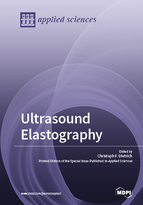Ultrasound Elastography
A special issue of Applied Sciences (ISSN 2076-3417). This special issue belongs to the section "Acoustics and Vibrations".
Deadline for manuscript submissions: closed (31 March 2018) | Viewed by 51308
Special Issue Editor
Interests: elastography; endoscopy; endoscopic ultrasound; contrast enhanced ultrasound; hepatitis; cancer
Special Issues, Collections and Topics in MDPI journals
Special Issue Information
Dear Colleagues,
As Guest Editor I am happy to invite authors from all over the world to contribute original data or review to a Special Issue on "Ultrasound Elastography" in the open access journal Applied Sciences (ISSN 2076-3417). High quality papers will be free of charge.
The European Federation of Societies for Ultrasound in Medicine and Biology (EFSUMB) published the first elastography guidelines in 2013 (basic principles, clinical applications) and the most current liver update (2017), which has been followed by the elastography guidelines from the World Federation for Ultrasound in Medicine and Biology (WFUMB) (basic principles, liver, breast, thyroid and prostate). The comparison between methods, evaluation of portal hypertension and many other questions are still open issues in liver elastography. New elastographic applications are under evaluation and close to being used in clinical practice. Strain imaging has been incorporated into many disciplines and EFSUMB guidelines are under preparation. More research is necessary for improved evidence for clinical applications in daily practice. Please consider submitting your high-quality papers for this Special Issue.
Prof. Christoph F. Dietrich, MBA
EFSUMB President 2013–2015
Guest Editor
Manuscript Submission Information
Manuscripts should be submitted online at www.mdpi.com by registering and logging in to this website. Once you are registered, click here to go to the submission form. Manuscripts can be submitted until the deadline. All submissions that pass pre-check are peer-reviewed. Accepted papers will be published continuously in the journal (as soon as accepted) and will be listed together on the special issue website. Research articles, review articles as well as short communications are invited. For planned papers, a title and short abstract (about 100 words) can be sent to the Editorial Office for announcement on this website.
Submitted manuscripts should not have been published previously, nor be under consideration for publication elsewhere (except conference proceedings papers). All manuscripts are thoroughly refereed through a single-blind peer-review process. A guide for authors and other relevant information for submission of manuscripts is available on the Instructions for Authors page. Applied Sciences is an international peer-reviewed open access semimonthly journal published by MDPI.
Please visit the Instructions for Authors page before submitting a manuscript. The Article Processing Charge (APC) for publication in this open access journal is 2400 CHF (Swiss Francs). Submitted papers should be well formatted and use good English. Authors may use MDPI's English editing service prior to publication or during author revisions.
Keywords
-
Elastography
-
strain
-
Liver stiffness
-
shear waves
-
stiffness
-
thyroid
-
prostate
-
breast
-
musculoskeletal
-
pancreas






